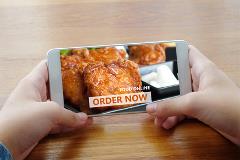COMBATING A SCATTERED CUSTOMER ORDERING PROCESS
Traditionally, the process behind a point of sale for Quick Service Restaurants (QSR’s) happened in the following ways:
-
- A customer placed their order verbally, through a drive-thru speaker, with a restaurant associate inside the store.
-
- Physical payment, be it a credit card or some cash, was exchanged for a food order.
- A given QSR’s sale process occurred at a business’ location.
Unless your franchise is under a rock, you’re already starting to see those three ways lose their footing. With the help of Smart Phones, social media, and those mysterious millennials, the order process can now take place wherever the consumer so chooses, without any customer-employee interface, and without the minor discomfort of manually forking over a payment for a service.
 WHAT DOES THIS MEAN FOR YOUR BUSINESS?
WHAT DOES THIS MEAN FOR YOUR BUSINESS?
This means a switch in control. Consumers, instead of you, now decide where and how where the customer ordering process happens, and it can occur virtually anywhere. Your ability to influence customers’ buying decisions with what’s on your menu and what your employees up-sell considerably shrinks with this change. Adding on, customers have no interface with money in exchange for food – PayPal or an online payment option takes care of the messy business while customers simply place orders and eat food.
These unavoidable developments push many fast food restaurants to follow the sink-or-swim approach.
With the help of a Smart Phone or tablet:
-
- Customers may only get an impression of your brand with an ordering app, but not your franchise. And if your franchise doesn’t support that app, then they may go to a competing franchise that does support that app.
- The only interaction customers get with your brand is the food and packaging, if they use a 3rd party service, such as DoorDash or UberEATS.
HOW DO WE SWIM INSTEAD OF SINK?
The majority of customers still utilize the drive-thru, and will continue to do so for many years to come.
However, newer, younger consumers are now looking for either extreme efficiency, or extreme experience. Extreme efficiency means setting up an app for smart phone users to order your food. But, that can cost a significant amount of money in hiring software engineers, configuring an integration system for your current hardware, upgrading each store’s OCS (order confirmation system), the list (and budget) goes on. Extreme experience means customizing your restaurant’s presentation for customers, which is a lot more doable.
In Toast’s Restaurant Technology report last year, based on 1,115 diners throughout the country, a couple facts stood out: 79% of diners feel newer technology makes for a positive guest experience, and 56% of adults agree they would spend more money for experiences versus simply buying something and leaving (like at a drive-thru).
Upgrading your restaurant’s furniture, music choices, technology, and menu displays are easy fixes with long-term solutions. People are now focused on experiences, and if you provide a unique, up-to-date one, customers will come back for more, and even bring publicity to your brand via social media and the World Wide Web. And when your consumers feel good about your brand and the experiences associated with it, they will continue to use the drive-thru and even pay the old-fashioned way, since your brand is current and has a fun personality.
It’s true, the customer ordering process has scattered in only a few years’ time. But you and your business can keep up with consumers’ needs, lifestyles, and trends, while staying in business. A technological face-lift may be all you need to drive more traffic to your QSR.
